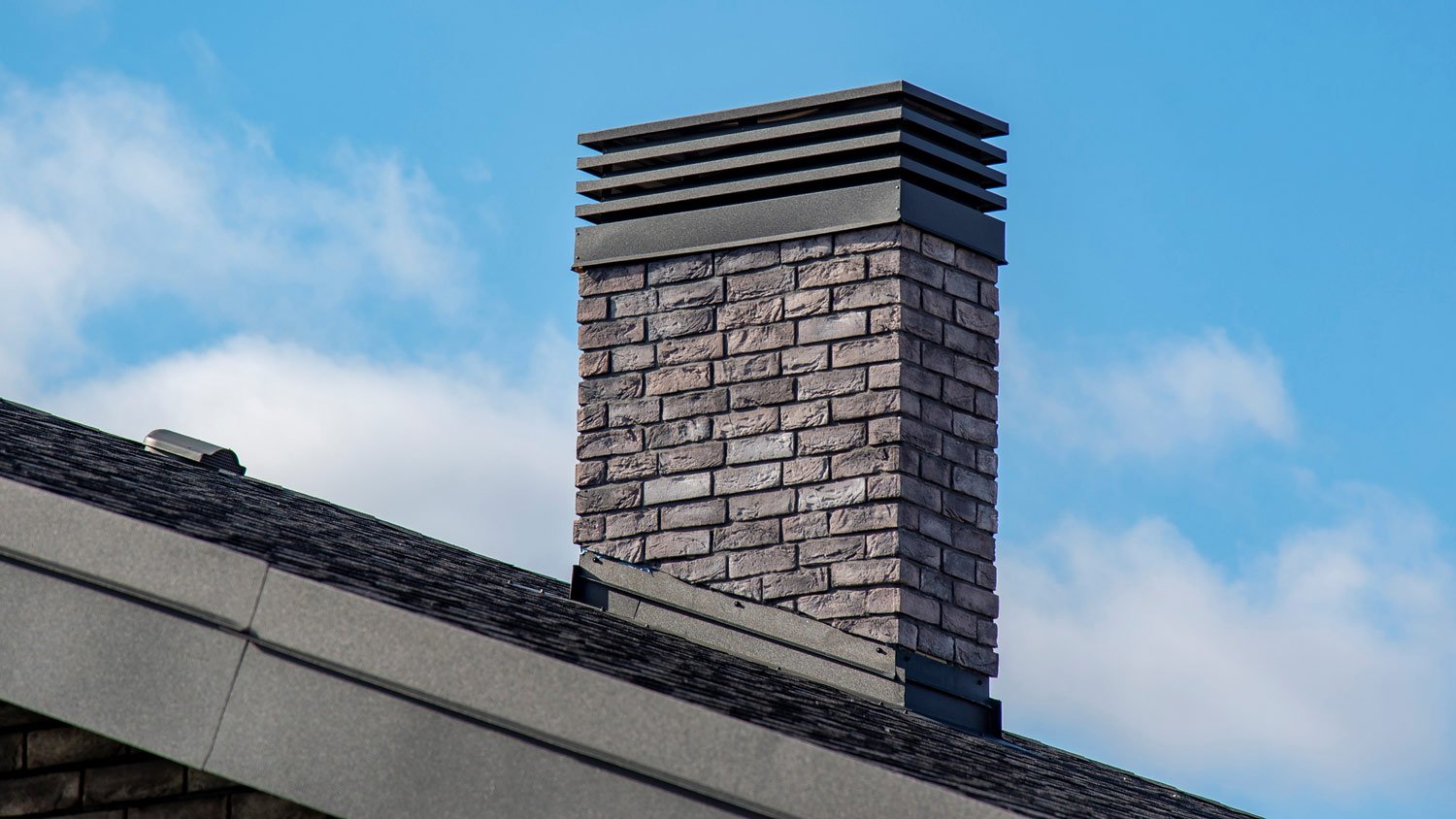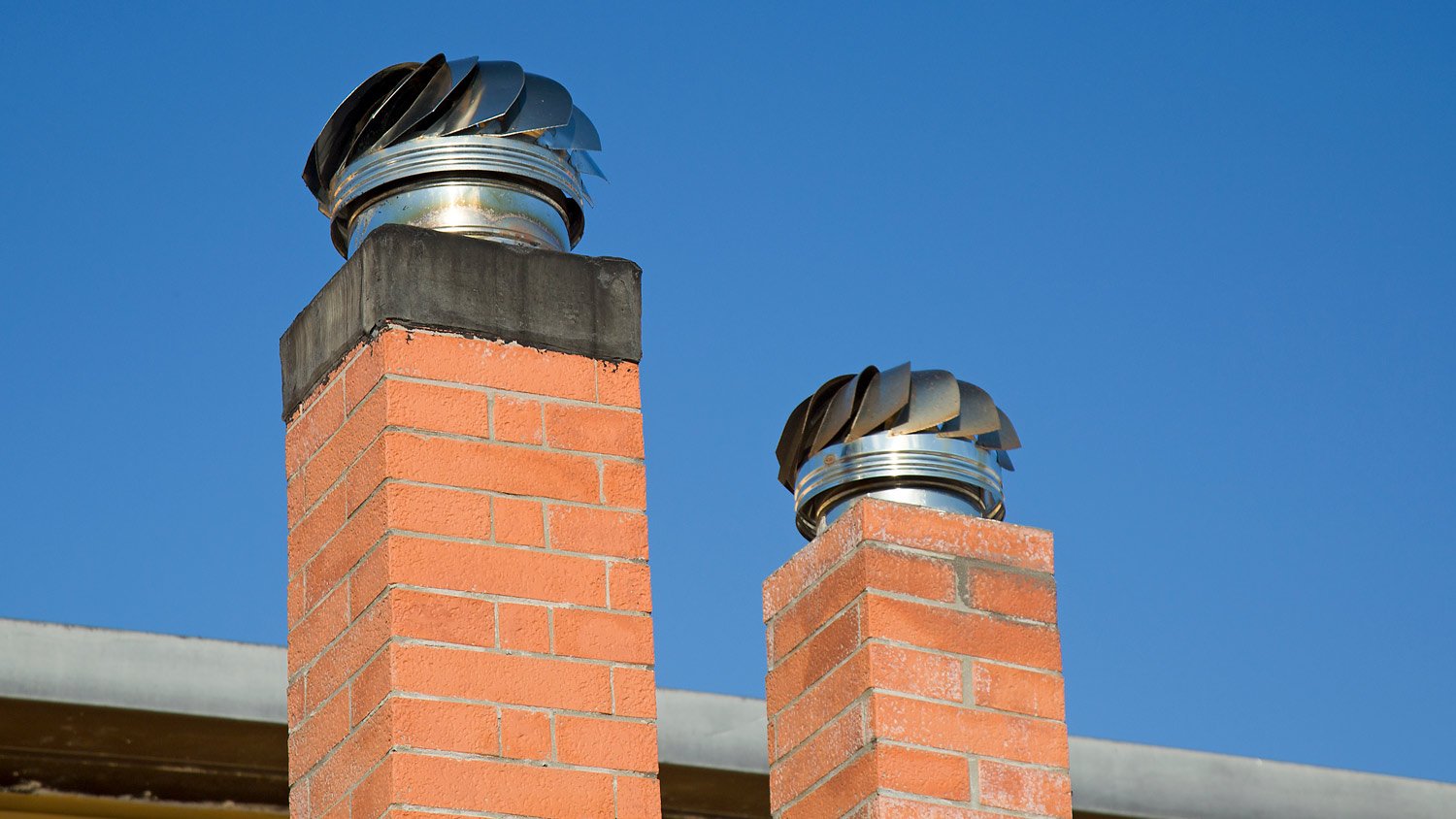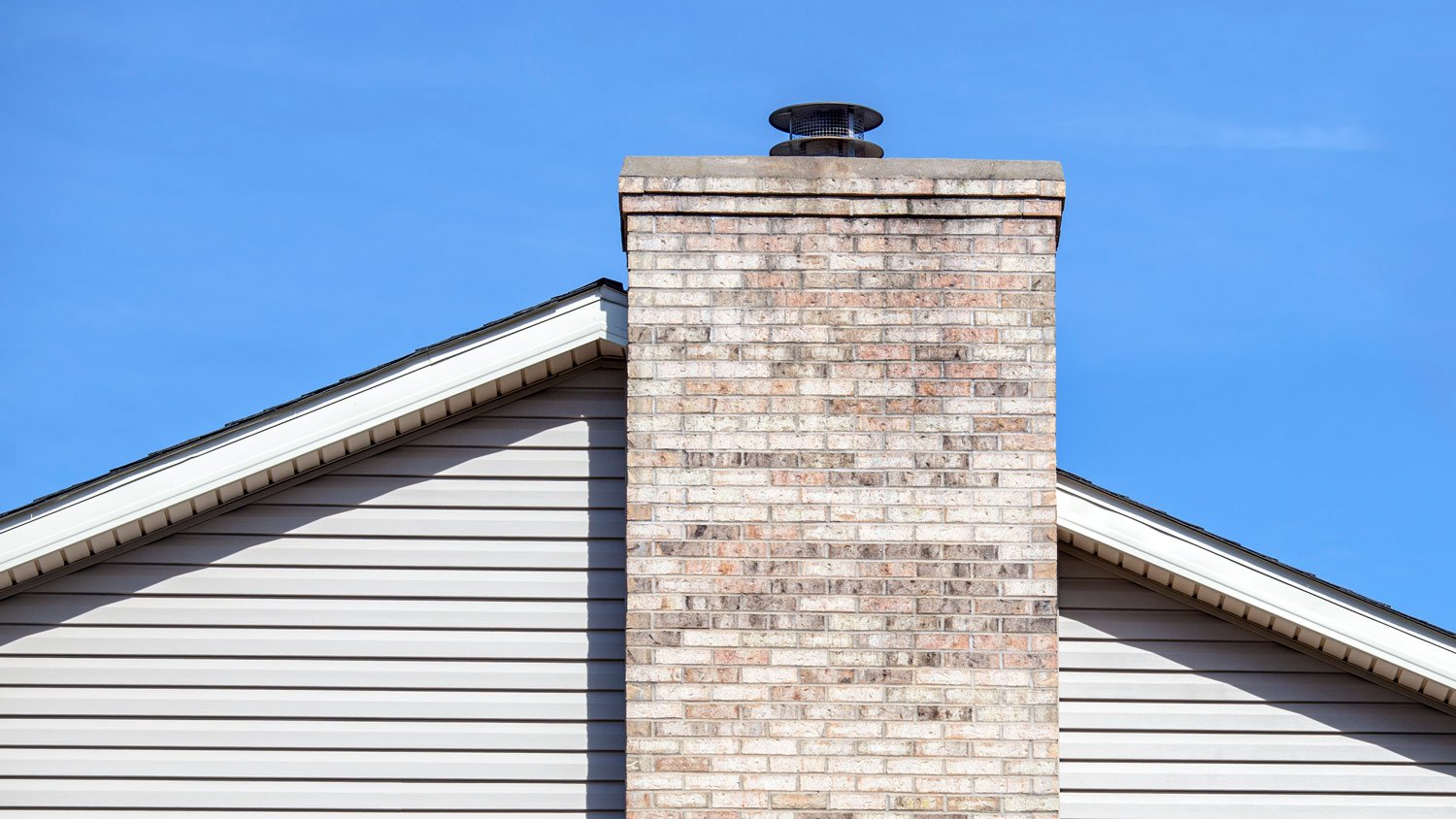
Find out the average chimney cap replacement cost, key price factors, and ways to save and budget for your chimney cap project.
It’s an investment that offers important protection


Chimney caps do more than just top off your chimney—they’re key to enhancing fireplace protection and performance. There are six main types of chimney caps: Band-around brick chimney caps, multi-flue chimney caps, side-mount chimney caps, wind directional chimney caps, electric draft-inducing chimney caps, and weather shield chimney caps. Below, we break down the pros and cons of each to help you choose.

A band-around brick chimney cap wraps snugly around the perimeter of a brick chimney, offering complete protection with a mesh screen and hood that animals typically can’t penetrate. The hood is vital to fireplace performance, boosting a home’s energy efficiency by keeping cold air out.
Instead of bolts, it’s secured with aluminum clamps, which provide superior weather protection compared to nuts and bolts by sealing out the elements completely. These clamps also help prevent moisture from penetrating the masonry, reducing the risk of cracks or deterioration over time. For the best results, professional installation is recommended to ensure a perfect fit and optimal protection.
| Pros | Cons |
|---|---|
| Full protection | Pro installation |
| Durable fit | Aluminum is soft |
| Keeps animals out | Aluminum corrodes |
| Energy efficient | Mesh can clog |
Best for homes with external brick chimneys
Multi-flue chimney caps cover and protect multiple flues within a single chimney structure, offering a streamlined appearance and enhanced protection. They’re ideal for large chimneys venting several fireplaces, heating appliances like gas furnaces, oil boilers, or a combination.
A multi-flue cap provides a unified cover, shielding all the flues from the elements while improving the overall efficiency and safety of the chimney system. These caps are heavier than single-flue options and often come with integrated spark guards, which help prevent embers from escaping the chimney and potentially igniting a fire on the roof or in the surrounding area. This is especially vital in wildfire-prone areas.
While homeowners can expect a higher initial cost due to the complexity of installation, the benefits in terms of safety, durability, and appearance typically make it a worthwhile investment.
| Pros | Cons |
|---|---|
| Full coverage | Complex install |
| Improved function | Expensive |
| Unified look | Heavy |
| Spark protection | Multi-flues only |
Best for homes with multiple fireplaces or heating appliances that require venting
Also known as outside-mount chimney caps, side-mount caps are an excellent choice for maximizing chimney protection with enhanced stability. They are particularly well-suited for chimneys with uncommon shapes, as they can be easily customized to fit a variety of structures.
Unlike other caps that attach directly to the top of the chimney, side-mount caps feature a skirt that wraps around the upper portion of the chimney, where the brick meets the crown, providing an additional barrier against the elements. This extra layer of defense helps preserve the integrity of your chimney, potentially reducing the need for costly repairs over time.
However, it's important to note that the screws or brackets used to secure the cap can place stress on the masonry over time if not installed correctly. This could lead to cracks or damage in the brickwork, especially if the chimney is older or already showing signs of wear. Additionally, since these caps wrap around the chimney, accessing the flue for cleaning may be more challenging.
| Pros | Cons |
|---|---|
| Maximum protection | Complex install |
| Customizable | Expensive |
| Enhanced stability | Harder to clean |
| May reduce repairs | Can crack brickwork |
Best for homes with uniquely shaped chimneys

A wind-directional chimney cap tackles strong winds head-on. It stops the wind from sneaking down the flue and causing cold downdrafts. Instead, it diverts winds to enhance the updraft, ensuring smoke is efficiently pulled up and out of your chimney.
How does it work, exactly? Its innovative design guides wind around the chimney’s top, blocking it from entering the flue. As the wind speeds past, it creates a sort of vacuum above the chimney, which naturally pulls the smoke upward. The stronger the wind blows, the better the draft. Another benefit: The updrafts it creates can prevent chimney fires.
These caps may need more than annual cleanings to clear out any smoke residue and deposits that can accumulate in the rotating turbines. Additionally, some homeowners say the turbines are noisy and also not very attractive.
| Pros | Cons |
|---|---|
| Prevents downdrafts | Complex install |
| Keeps cold air out | Noisy |
| Helps prevent chimney fires | Limited designs |
| Durable | Needs regular cleaning |
Best for homes in areas that experience extreme winds
If you're still experiencing issues with your fireplace's draft or ventilation, consider an electric draft-inducing chimney cap. These caps are equipped with fans that allow you to precisely control the draft flow in your chimney, helping you achieve the ideal balance.
Suitable for both wood and gas fireplaces, these caps actively draw smoke out of the flue, improving ventilation and enhancing safety.
However, keep in mind that these caps are more complex to install and typically require professional installation to ensure proper functionality. Since they rely on electricity, you may encounter higher energy costs and potential maintenance issues. Additionally, some homeowners might find the noise from the fans a bit distracting.
| Pros | Cons |
|---|---|
| Precise control | Complex install |
| Enhanced safety | Higher energy costs |
| Better burn efficiency | Mechanical risk |
| Versatility | Noisy |
Best for homes needing more advanced ventilation

A weather shield chimney cap protects against extreme and harsh weather conditions, including snow, heavy rains, and strong winds, expanding the longevity of your chimney. These caps are made of resilient stainless steel that resists weather and flue gas-related corrosion.
Unlike standard chimney caps, which mainly focus on keeping out debris and animals, a weather shield cap features a large sloped top that effectively diverts the elements from the chimney opening. This design ensures your chimney and home stay dry and protected, regardless of the weather. However, its larger profile can create wind resistance, potentially causing noise.
| Pros | Cons |
|---|---|
| Best moisture defense | Larger profile |
| Durable construction | Higher costs |
| Enhanced longevity | Complex install |
| Stops downdrafts | Noisy |
Best for homes in areas that experience harsh weather
Most homeowners with a single-flue chimney install one chimney cap. However, there are situations in which multiple caps are needed, such as homes with a multi-flue chimney.
A chimney cap installer has the expertise to recommend the number of chimney caps your home needs to protect the chimney and prevent blockages. They also have the tools and skills to work safely on your roof and properly install the caps.
When buying a chimney cap, homeowners should consider the following factors.
You want your cap to fit your chimney's dimensions and the number of flues. Working with a professional chimney cap installer will ensure you pick the right cap for your home's needs.
Select a material that works for your local weather conditions. For example, stainless steel is durable and rust-resistant, making it a reliable choice. On the other hand, copper has a long lifespan and adds a touch of elegance. If you're looking for a more budget-friendly option, galvanized steel is a good choice, although it may not offer the same longevity.
Chimney caps are available in a range of styles and materials. Choose a cap that complements your home's exterior. Decorative caps can enhance curb appeal, while more functional designs may blend better with your roofline.
Some caps, like wind-resistant or electric caps, may require more frequent maintenance. Choose a cap that matches your willingness and ability to perform regular upkeep.
Determine whether you want to install the cap or hire a pro. Some caps, like top-mount or electric draft-inducing caps, require specialized tools or expertise. Also working on top of a roof in itself is a specialized skill.
Check local building codes or HOA guidelines to ensure the cap you choose complies with specific regulations in your area. This is another good reason to work with a professional who’s familiar with local policies.
From average costs to expert advice, get all the answers you need to get your job done.

Find out the average chimney cap replacement cost, key price factors, and ways to save and budget for your chimney cap project.

A chimney cap helps keep your chimney in good working order. But who installs chimney caps? Our guide will help you pick the right pro for the job.

Discover how to install a chimney cap, what to consider whn purchasing a chimney cap, and the benefits of chimney cap installation.

Flue cap vs. chimney cap—how do you know which one you need? Learn more about the differences between a flue cap and chimney cap.

Not all chimneys have caps, but most fireplaces can benefit from having one. But what is a chimney cap, and why is it important? Our guide breaks it all down.